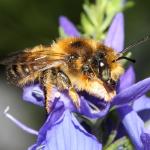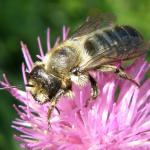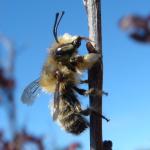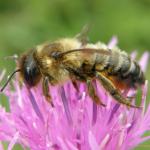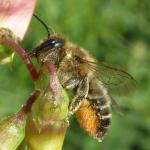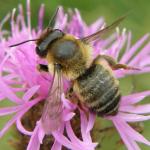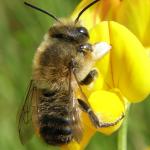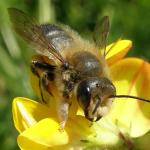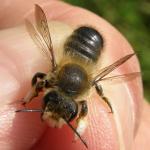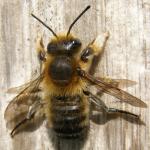Megachile atriventris SCHENCK 1853
An identification key is available (Else, 1999). Females from the British mainland and the Isle of Man have black scopal hairs on the fifth and sixth sterna, those occurring in Ireland have the sternum with the entire scopa reddish-golden.
Megachile willughbiella is one of the most frequently observed and widely distributed leafcutter bees in the British Isles. It is found from the Isles of Scilly through Cornwall and Devon northwards, though sporadically, to Inverness, Scotland. Also recorded in Ireland and the Channel Islands. Records naturally are less frequent the more northerly one travels. Despite its wide geographical spread there are still gaps in its current distribution. Mid and north Wales and the north Midlands appear not to support this species though this is possibly a consequence of limited recording activity in these regions rather than a restriction in range. It should also be noted that these potentially under-recorded regions are high altitude which may have a bearing on this species’ abundance and distribution.
It occurs in western Europe from Spain to Lithuania and Finland.
This species is not regarded as scarce or threatened.
Found in a variety of habitats where there is suitable nesting and foraging. Gardens and brownfield sites are frequently visited and used for nesting by this species, particularly in the main centres of conurbation in England.
Mid-June through July and into early August is the optimum flight period for this species.
Nests can be located either in wood or soil, there is also a record of a nest in a length of rubber hose in a greenhouse (Else, 1999). The cells are constructed from leaves including beech and tutsan.
Bellflowers, bird’s-foot-trefoils, thistles and brambles are all visited by M. willughbiella.
Coelioxys quadridentata (Linnaeus), C. rufescens Lepeletier & Serville, and C. elongata Lepeletier are all recorded as being cleptoparasites of M. willughbiella.
2012


